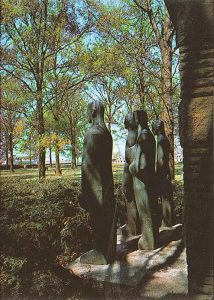Ostende, Belgium –
The history and landscape of the province of West Flanders in northern Belgium are marked by the great battles of World War I and the enormous casualties they caused which account for the hundreds of war cemeteries and memorials, including museums. This was reflected in the theme of the fourth conference, ‘From war remembrance to peace education’, that was held in Flanders in May 2003.
 The conference took place in the coastal resort of Ostend and included field trips to two major museums in the region – In Flanders Fields museum (Ieper) and the Iron Tower (IJzertoren, Diksmuide). The conference programme also included a meeting in the European Parliament in Brussels. The two World Wars that originated in Europe in the first half of the 20th century which caused untold destruction, death and suffering, provided the main stimulus for the attempt to forge a united, peaceful Europe, launched in earnest in the 1950s. The creation of the European Parliament is the concrete embodiment of this ideal. Already three centuries before, when Europe was embroiled in war, the English Quaker William Penn had proposed the creation of just such a body to prevent future wars in An Essay Towards the Present and Future Peace of Europe (1693).
The conference took place in the coastal resort of Ostend and included field trips to two major museums in the region – In Flanders Fields museum (Ieper) and the Iron Tower (IJzertoren, Diksmuide). The conference programme also included a meeting in the European Parliament in Brussels. The two World Wars that originated in Europe in the first half of the 20th century which caused untold destruction, death and suffering, provided the main stimulus for the attempt to forge a united, peaceful Europe, launched in earnest in the 1950s. The creation of the European Parliament is the concrete embodiment of this ideal. Already three centuries before, when Europe was embroiled in war, the English Quaker William Penn had proposed the creation of just such a body to prevent future wars in An Essay Towards the Present and Future Peace of Europe (1693).
During a meeting with Flemish Members of the European Parliament, conference participants submitted three proposals for presentation to parliament, including one for the creation of a European Peace Museum.
The In Flanders Fields museum was inaugurated in 1998 in the centre of Ieper, in the historic, medieval Cloth Hall, an imposing building which was painstakingly reconstructed after its total destruction in World War I. The original Tower in Diksmuide was opened in 1930 and destroyed in 1946 by a criminal act. A new tower, 84-metre high and comprising 24 floors of museum exhibits, was opened in 1965.
 Conference participants also made a tour of the battlefield sites around Ieper with visits to some of the most important war memorials and war cemeteries for which the region is famous. They included the impressive German military cemetery in Vladslo where Käthe Kollwitz’s moving sculpture of grieving parents stands in front of the grave of her young son, one of the first casualties of war in 1914.
Conference participants also made a tour of the battlefield sites around Ieper with visits to some of the most important war memorials and war cemeteries for which the region is famous. They included the impressive German military cemetery in Vladslo where Käthe Kollwitz’s moving sculpture of grieving parents stands in front of the grave of her young son, one of the first casualties of war in 1914.
The terrible devastation of a long war (1914-1918) left permanent scars on the landscape and a deep revulsion against war among the suffering population. It is no surprise that in recent decades the province of West Flanders has defined itself as a peace region, and that Ieper is officially a peace city.
The fourth conference was generously supported by the provincial government of West Flanders as well as by the government of the Flemish region (Flanders). Grateful thanks are due to Lionel Vandenberghe and Dirk Demeurie, respectively chairman and general secretary of the charitable organisation ‘Pilgrimage to the Graves at the IJzer’ (that administers the IJzer Tower) for hosting the conference, and to Piet Chielens, director of In Flanders Fields museum for hosting the day in Ieper.

